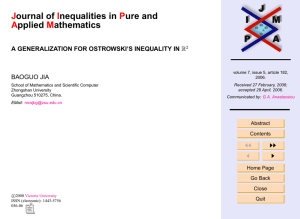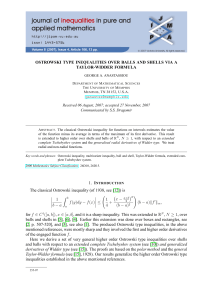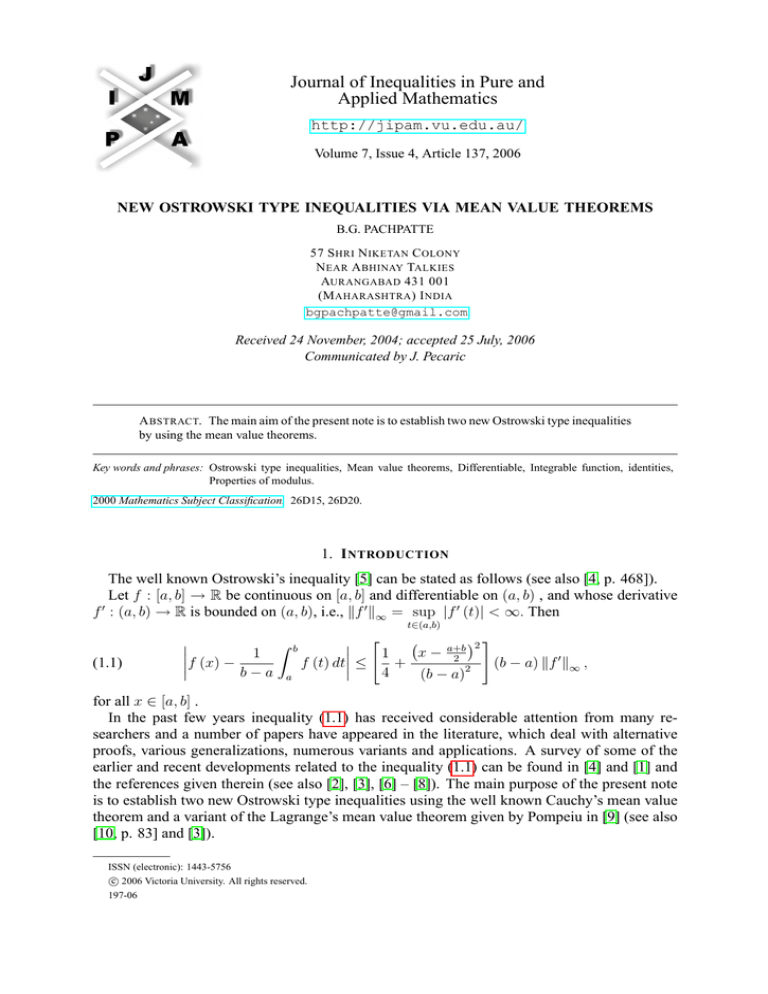
Journal of Inequalities in Pure and
Applied Mathematics
http://jipam.vu.edu.au/
Volume 7, Issue 4, Article 137, 2006
NEW OSTROWSKI TYPE INEQUALITIES VIA MEAN VALUE THEOREMS
B.G. PACHPATTE
57 S HRI N IKETAN C OLONY
N EAR A BHINAY TALKIES
AURANGABAD 431 001
(M AHARASHTRA ) I NDIA
bgpachpatte@gmail.com
Received 24 November, 2004; accepted 25 July, 2006
Communicated by J. Pecaric
A BSTRACT. The main aim of the present note is to establish two new Ostrowski type inequalities
by using the mean value theorems.
Key words and phrases: Ostrowski type inequalities, Mean value theorems, Differentiable, Integrable function, identities,
Properties of modulus.
2000 Mathematics Subject Classification. 26D15, 26D20.
1. I NTRODUCTION
The well known Ostrowski’s inequality [5] can be stated as follows (see also [4, p. 468]).
Let f : [a, b] → R be continuous on [a, b] and differentiable on (a, b) , and whose derivative
0
f : (a, b) → R is bounded on (a, b), i.e., kf 0 k∞ = sup |f 0 (t)| < ∞. Then
t∈(a,b)
(1.1)
#
"
Z b
a+b 2
x
−
1
1
2
f (x) −
(b − a) kf 0 k∞ ,
f (t) dt ≤
+
b−a a
4
(b − a)2
for all x ∈ [a, b] .
In the past few years inequality (1.1) has received considerable attention from many researchers and a number of papers have appeared in the literature, which deal with alternative
proofs, various generalizations, numerous variants and applications. A survey of some of the
earlier and recent developments related to the inequality (1.1) can be found in [4] and [1] and
the references given therein (see also [2], [3], [6] – [8]). The main purpose of the present note
is to establish two new Ostrowski type inequalities using the well known Cauchy’s mean value
theorem and a variant of the Lagrange’s mean value theorem given by Pompeiu in [9] (see also
[10, p. 83] and [3]).
ISSN (electronic): 1443-5756
c 2006 Victoria University. All rights reserved.
197-06
2
B.G. PACHPATTE
2. S TATEMENT OF R ESULTS
In the proofs of our results we make use of the well known Cauchy’s mean value theorem
and the following variant of the Lagrange’s mean value theorem given by Pompeiu in [9] (see
also [3, 10]).
Theorem A. For every real valued function f differentiable on an interval [a, b] not containing
0 and for all pairs x1 6= x2 in [a, b], there exists a point c in (x1 , x2 ) such that
x1 f (x2 ) − x2 f (x1 )
= f (c) − cf 0 (c) .
x1 − x2
Our main results are given in the following theorems.
Theorem 2.1. Let f, g, h : [a, b] → R be continuous on [a, b], a < b; a, b ∈ R and differentiable
Rb
on (a, b) and w : [a, b] → [0, ∞) be an integrable function such that a w (y) dy > 0. If h0 (t) 6=
0 for each t ∈ (a, b), then
Z b
Z b
1
(2.1) f (x) g (x) − R b
f (x)
w (y) g (y) dy + g (x)
w (y) f (y) dy 2 a w (y) dy
a
a
(
)
R
0
0 b
g w
(y)
h
(y)
dy
f
1 |g (x)| + |f (x)|
≤
h (x) − a R b
.
h0 2 h0 ∞
w
(y)
dy
∞
a
for all x ∈ [a, b] , where
0
0 f = sup f (t) < ∞,
h0 0 t∈(a,b) h (t)
∞
0
0 g = sup g (t) < ∞.
h0 0 t∈(a,b) h (t)
∞
Theorem 2.2. Let f, g : [a, b] → R be continuous on [a, b], a < b; a, b ∈ R and differentiable
on (a, b) with [a, b] not containing 0 and w : [a, b] → [0, ∞) an integrable function such that
Rb
yw(y)dy > 0. Then
a
Z b
Z b
1
(2.2) f (x) g (x) − R b
xf (x)
w (y) g (y) dy + xg (x)
w (y) f (y) dy 2 a yw (y) dy
a
a
R
b
x a w (y) dy 1
0
0
≤ {kf − lf k∞ |g (x)| + kg − lg k∞ |f (x)|} 1 − R b
,
2
yw (y) dy a
for all x ∈ [a, b] , where l(t) = t, t ∈ [a, b] and
kf − lf 0 k∞ = sup |f (t) − tf 0 (t)| < ∞,
t∈[a,b]
kg − lg 0 k∞ = sup |g (t) − tg 0 (t)| < ∞.
3. P ROOFS OF T HEOREMS 2.1
t∈[a,b]
AND
2.2
Let x, y ∈ [a, b] with y 6= x. From the hypotheses of Theorem 2.1 and applying Cauchy’s
mean value theorem to the pairs of functions f, h and g, h there exist points c and d between x
and y such that
(3.1)
f (x) − f (y) =
f 0 (c)
{h (x) − h (y)} ,
h0 (c)
(3.2)
g (x) − g (y) =
g 0 (d)
{h (x) − h (y)} .
h0 (d)
J. Inequal. Pure and Appl. Math., 7(4) Art. 137, 2006
http://jipam.vu.edu.au/
N EW O STROWSKI T YPE I NEQUALITIES
3
Multiplying (3.1) and (3.2) by g(x) and f (x) respectively and adding we get
(3.3)
2f (x) g (x) − g (x) f (y) − f (x) g (y)
=
g 0 (d)
f 0 (c)
g
(x)
{h
(x)
−
h
(y)}
+
f (x) {h (x) − h (y)} .
h0 (c)
h0 (d)
Multiplying both sides of (3.3) by w(y) and integrating the resulting identity with respect to y
over [a, b] we have
Z b
Z b
Z b
(3.4) 2
w (y) dy f (x) g (x) − g (x)
w (y) f (y) dy − f (x)
w (y) g (y) dy
a
a
a
Z b
Z b
f 0 (c)
= 0
g (x)
w (y) dy h (x) −
w (y) h (y) dy
h (c)
a
a
Z b
Z b
g 0 (d)
f (x)
w (y) dy h (x) −
w (y) h (y) dy .
+ 0
h (d)
a
a
Rewriting (3.4) we have
1
(3.5) f (x) g (x) − R b
2 a w (y) dy
Z b
Z b
f (x)
w (y) g (y) dy + g (x)
w (y) f (y) dy
a
(
=
a
1 f 0 (c)
g (x) h (x) −
2 h0 (c)
Rb
)
w (y) h (y) dy
Rb
w (y) dy
a
(
)
Rb
w
(y)
h
(y)
dy
1 g 0 (d)
+
f (x) h (x) − a R b
.
0
2 h (d)
w
(y)
dy
a
a
From (3.5) and using the properties of modulus we have
Z b
Z b
1
(3.6) f (x) g (x) − R b
f (x)
w (y) g (y) dy + g (x)
w (y) f (y) dy 2 a w (y) dy
a
a
Rb
0
1
f
|g (x)| h (x) − a Rw (y) h (y) dy ≤ b
2 h0 ∞
w (y) dy a
Rb
0
w
(y)
h
(y)
dy
1
g
a
+ 0 |f (x)| h (x) − R b
.
2 h ∞
w (y) dy a
Rewriting (3.6) we get the desired inequality in (2.1) and the proof of Theorem 2.1 is complete.
From the hypotheses of Theorem 2.2 and applying Theorem A for any y 6= x, x, y ∈ [a, b] ,
there exist points c and d between x and y such that
(3.7)
yf (x) − xf (y) = [f (c) − cf 0 (c)] (y − x) ,
(3.8)
yg (x) − xg (y) = [g (d) − dg 0 (d)] (y − x) .
Multiplying both sides of (3.7) and (3.8) by g(x) and f (x) respectively and adding the resulting
identities we have
(3.9) 2yf (x) g (x) − xg (x) f (y) − xf (x) g (y)
= [f (c) − cf 0 (c)] (y − x) g (x) + [g (d) − dg 0 (d)] (y − x) f (x) .
J. Inequal. Pure and Appl. Math., 7(4) Art. 137, 2006
http://jipam.vu.edu.au/
4
B.G. PACHPATTE
Multiplying both sides of (3.9) by w(y) and integrating the resulting identity with respect to y
over [a, b] we have
Z b
Z b
Z b
(3.10) 2
yw (y) dy f (x) g (x) − xg (x)
w (y) f (y) dy − xf (x)
w (y) g (y) dy
a
a
a
Z b
Z b
0
= [f (c) − cf (c)] g (x)
yw (y) dy − x
w (y) dy
a
a
Z b
Z b
0
+ [g (d) − dg (d)] f (x)
yw (y) dy − x
w (y) dy .
a
a
Rewriting (3.10) we get
1
(3.11) f (x) g (x) − R b
2 a yw (y) dy
Z b
Z b
xf (x)
w (y) g (y) dy + xg (x)
w (y) f (y) dy
a
a
(
=
Rb
x w (y) dy
1
[f (c) − cf 0 (c)] g (x) 1 − R b a
2
yw (y) dy
a
)
(
)
Rb
x
w
(y)
dy
1
+ [g (d) − dg 0 (d)] f (x) 1 − R b a
.
2
yw
(y)
dy
a
From (3.11) and using the properties of modulus we have
Z b
Z b
1
(3.12) f (x) g (x) − R b
xf (x)
w (y) g (y) dy + xg (x)
w (y) f (y) dy 2 a yw (y) dy
a
a
R
b
x a w (y) dy 1
0
≤ kf − lf k∞ |g (x)| 1 − R b
2
yw
(y)
dy
a
Rb
x
w
(y)
dy
1
+ kg − lg 0 k∞ |f (x)| 1 − R b a
.
2
yw
(y)
dy
a
Rewriting (3.12) we get the required inequality in (2.2). The proof of Theorem 2.2 is complete.
R EFERENCES
[1] S.S. DRAGOMIR AND T.M. RASSIAS (Eds.), Ostrowski Type Inequalities and Applications in
Numerical Integration, Kluwer Academic Publishers, Dordrecht 2002.
[2] S.S. DRAGOMIR, Some Ostrowski type inequalities via Cauchy’s mean value theorem, New
Zealand J. Math., 34(1) (2005), 31–42.
[3] S.S. DRAGOMIR, An inequality of Ostrowski type via Pompeiu’s mean value theorem, J. Inequal. Pure and Appl. Math., 6(3) (2005), Art. 83. [ONLINE: http://jipam.vu.edu.au/
article.php?sid=556].
[4] D.S. MITRINOVIĆ, J.E. PEČARIĆ AND A.M. FINK, Inequalities for Functions and Their Integrals and Derivatives, Kluwer Academic Publishers, Dordrecht, 1994.
[5] A.M. OSTROWSKI, Über die Absolutabweichung einer differentiebaren Funktion van ihrem Integralmittelwert, Comment. Math. Helv., 10 (1938), 226–227.
[6] B.G. PACHPATTE, On a new Ostrowski type inequality in two independent variables, Tamkang J.
Math., 32 (2001), 45–49.
J. Inequal. Pure and Appl. Math., 7(4) Art. 137, 2006
http://jipam.vu.edu.au/
N EW O STROWSKI T YPE I NEQUALITIES
5
[7] B.G. PACHPATTE, A note on Ostrowski and Grüss type discrete inequalities, Tamkang J. Math.,
35 (2004), 61–65.
[8] B.G. PACHPATTE, On a new generalization of Ostrowski’s inequality, J. Inequal. Pure and Appl.
Math., 5(2) (2004), Art. 36. [ONLINE: http://jipam.vu.edu.au/article.php?sid=
388].
[9] D. POMPEIU, Sur une proposition analogue au théorème des accroissements finis, Mathematica
(Cluj, Romania), 22 (1946), 143–146.
[10] P.K. SAHOO AND T. RIEDEL, Mean Value Theorems and Functional Equations, World Scientific,
Singapore, New Jersey, London, Hong Kong, 2000.
J. Inequal. Pure and Appl. Math., 7(4) Art. 137, 2006
http://jipam.vu.edu.au/


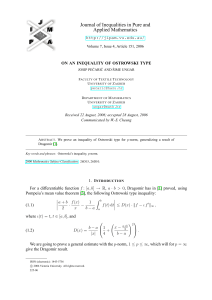
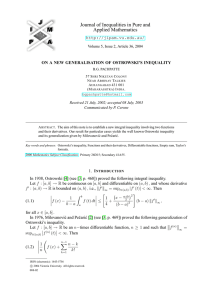



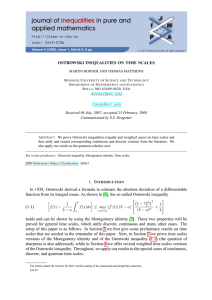
![ON THE WEIGHTED OSTROWSKI INEQUALITY I [5], (1.1)](http://s2.studylib.net/store/data/010717215_1-54ec7398ab903a21d10e53796295a83a-300x300.png)

